NRAO eNews
Volume 11, Issue 2
8 February 2018
Upcoming Events

AAAS – The Chemistry & Physics of Nascent Planet Formation
Feb 17, 2018 | Austin, TX

2018 NRAO Postdoctoral Symposium
Mar 19 - 20, 2018 | Socorro, NM

NRAO/LBO Community Day at Caltech
Mar 27 - 28, 2018 | Pasadena, CA

Synthesis Imaging Workshop
May 16 - 23, 2018 | Socorro, NM

Astrophysical Frontiers in the Next Decade and Beyond
Jun 26 - 29, 2018 | Portland, OR

Tracing the Flow: Galactic Environments and the Formation of Massive Stars
Jul 2 - 6, 2018 | Lake Windermere, UK
VLA Sky Survey Status
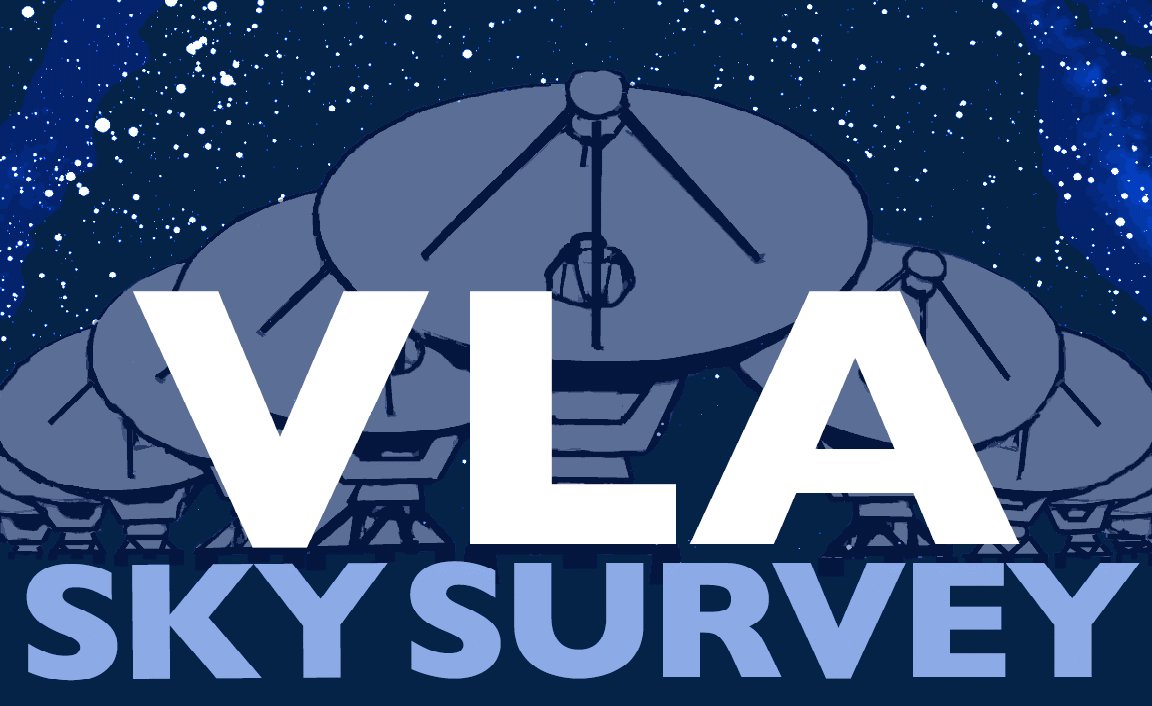
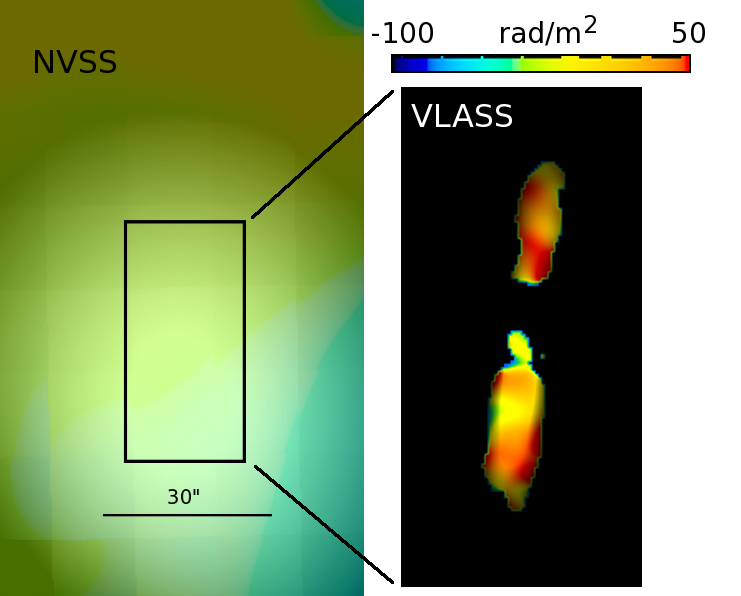
Rotation measure for the source 3C402N based on NVSS data (left), and the same derived from VLASS Basic Data Products (right). Images courtesy Larry Rudnick (Minnesota).
[click to enlarge]
Observing for the first half of the first epoch of the VLA Sky Survey (VLASS1.1) is well underway. Almost 13,000 square degrees of sky were observed in the B configuration just completed, and the VLA has now moved into a special BnA hybrid configuration, where it will stay for two weeks, to support observing of southern declinations. At the same time NRAO has already released 6,900 square degrees of "Quick Look" images based on the B-configuration data, and is working to release the remainder of VLASS1.1 after the hybrid observing has finished. The Quick Look images are intended to be used only for transient science, since they have large pixels and are cleaned only to between 5 and 10 sigma. Nevertheless, they already demonstrate the importance of the improved resolution of the survey compared with previous surveys.
The definition of which parts of the sky are being covered during VLASS1.1, and access to the Quick Look images, is online.
The VLASS Project Team is working on the calibration and imaging pipelines for the full quality Single Epoch data products, which will start to be delivered later this year. Further information about the survey is at the NRAO Science Website. We encourage anyone interested to join the VLASS Science Working Group, for which the instructions for participating are also at this link.
Registration Open for Synthesis Imaging Workshop

The 16th Synthesis Imaging Workshop will be held 16-23 May 2018 at the NRAO and the New Mexico Institute of Mining and Technology in Socorro, New Mexico. The workshop will comprise four days of lectures on aperture synthesis theory and techniques at a level appropriate for graduate students in astrophysics. The workshop will also include two days of practical tutorials demonstrating data collection, calibration, and imaging of data from the Very Large Array, Atacama Large Millimeter/submillimeter Array, the Long Wavelength Array and the Very Long Baseline Array.
Please visit the workshop website to register and for further information on scheduled lectures, events and logistics such as lodging and transportation. Registration is now open and will continue on a first-come, first-served basis until the limit of 150 participants is reached.
For participants attending from outside the U.S., our understanding of current policy is that attending a scientific workshop in the U.S. should only require a visitor visa. Should you need a letter of invitation, please select that option when registering. We strongly encourage you to start paperwork early.
The National Radio Astronomy Observatory, the New Mexico Institute of Mining and Technology, and the University of New Mexico sponsor the Synthesis Imaging Workshop.
ngVLA Program News

ngVLA Science Book
The ngVLA science case volume is in preparation and is a major deliverable to the Astronomy 2020 Decadal Survey. This science volume is being crafted by the ngVLA Science Advisory Council, in consultation with the astronomical community at large, and the ngVLA Project Scientist. The volume will provide an extremely useful summary of the ngVLA Key Science Mission for Astro2020 panel members, as well as demonstrate the Project's firm handle on the associated technology requirements and cost, and will be published in the Astronomical Society of the Pacific monograph series. This will ensure that the book and individual chapters will be listed in the SAO/NASA Astrophysics Data System for maximum visibility to the Astro 2020 panel members.
An initial table of contents identifying potential lead authors will be updated regularly. If you would like to contribute a chapter, please contact the appropriate Science Working Group (SWG) Chair and download the necessary template and instructions. First Draft chapters are due to either SWG chairs or the ngVLA project scientist by 31 March 2018. Additional contributions for the final book will still be accepted after this.
Astrophysical Frontier in the Next Decade and Beyond (26 – 29 June 2018 Portland, Oregon)
We are pleased to announce that registration is now open for the conference Astrophysical Frontiers in the Next Decade and Beyond: Planets, Galaxies, Black Holes, and the Transient Universe. This ambitious conference will bring together a large cross-section of the multi-wavelength astronomical community to discuss how best to tackle the most pressing astrophysical questions in the near-future. This conference will consist of plenary sessions of invited speakers and three parallel sessions that will include invited and contributed presentations covering Origins of Exoplanets and Protoplanetary Disks; Mechanisms of Galaxy Evolution; and Black Holes and Transient Phenomena. While this meeting is sponsored by NRAO, the science areas explored are truly multi-wavelength/messenger, and the science program has strong representation from communities across the electromagnetic spectrum. We hope to see you in Portland in June!
Career Opportunities
The project is interviewing candidates for a:
- Configuration Research Associate
- Array Calibration Research Associate
- Science Community Support Research Associate
Community-Driven Activities
Given the success of our first round of ngVLA Community Studies, a second round was initiated to tackle some of the most pressing questions unveiled by the initial studies. The primary objective for the second round of community studies is to further develop the Key Science Goals outlined in Memo #19. Studies and simulations were asked to focus on addressing these key science goals, and better quantifying the expected performance of the array while providing additional supporting technical requirements.
The second call yielded 12 approved scientific studies. All accepted Community Studies efforts from this second round are expected to write up their findings as part of a peer-refereed journal article or ngVLA memo, and present their progress/final results at the Astrophysical Frontiers in the next Decade and Beyond conference, 26-29 June 2018 in Portland, Oregon.
American Astronomical Society Meeting – Special Session
NRAO held a special session at the most recent American Astronomical Society meeting in National Harbor, Maryland titled The Very Large Array Today and Tomorrow. This session included oral presentations and ~30 coordinated posters. We would like to thank all community participants for making this special session a resounding success! All presentations have been posted online.
2018 Jansky Lectureship – Call for Nominations
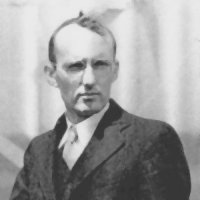
Karl Jansky
The Karl G. Jansky Lectureship is an honor established by the trustees of Associated Universities, Inc., to recognize outstanding contributions to the advancement of radio astronomy. First awarded in 1966, it is named in honor of the man who, in 1932, first detected radio waves from a cosmic source. Karl Jansky's discovery of radio waves from the central region of our Milky Way Galaxy started the science of radio astronomy.
The 2018 Jansky Lecturer will have made significant contributions related to radio astronomy, and will promote the appreciation of the science of radio astronomy through public lectures at the NRAO sites. A demonstrated ability to engage a wide audience will be a factor in determining the awardee. Visit the Jansky Lectureship website for a list of the previous recipients of this prestigious award.
Additional information, including the nomination and selection process, is available online.
Nominations for the 2018 award should be concise (~1 page) and address both the nominee’s contribution to the advancement of radio astronomy and their potential to increase public appreciation through the Jansky Lecture.
Nominations should be sent to jutley@nrao.edu by 5 March 2018.
NRAO scientific staff will be given an opportunity to vote on nominations received and the results will be included in the recommendation to the NRAO Director.
ALMA Program News
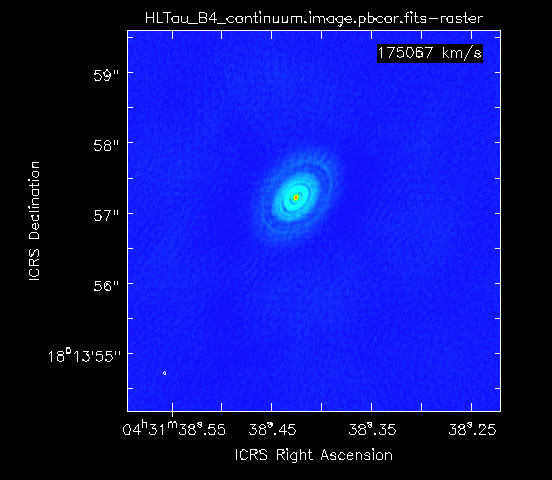
ALMA Band-4 Science Verification Data, HL Tauri
[click to enlarge]
ALMA observing has stopped for the austral summer. ALMA will be in engineering shutdown until 28 February, when observations will resume in configuration C43-4 (0”.9 beam at 100 GHz, 15m to ~0.8km baselines) and will then continue shrinking to more compact configurations. Access to the archive and science portal will be unavailable (or very limited) in a period from 02 – 12 February 2018 (inclusive) due to planned maintenance.
The ALMA Cycle 6 Call for Proposals will be released on the ALMA Science Portal on 20 March 2018. New information useful for planning is available in the ALMA Science Portal, including the Cycle 6 configuration schedule, information pertaining to planning for Large Programs, and on circular polarization. Additional information may be found in the Cycle 6 pre-announcement posted previously to the portal.
New data are listed on the Science Verification data page (source #15: HL Tau). The observations are of HL Tau at high-angular resolution (~50 mas) at 140 GHz (Band 4, continuum-mode) made with the 12-m Array. The raw data, calibrated data, reference images, and reduction scripts are available for download.
At their November 2017 meeting, the ALMA Board approved the development of a new
spectrometer for the Morita Array designed and developed by Japan for the ALMA telescope. The development will be undertaken by Korea Astronomy and Space Science Institute (KASI) and the National Astronomical Observatory of Japan (NAOJ) as part of the ALMA Future Development Program aiming to keep ALMA continuously producing remarkable scientific results long into the future.
Elements of the ALMA2030 program of new science opportunities with ALMA were discussed at a special session at the North American Radio Science meeting in Boulder 4-7 January 2018. The presentations are available. The next NAASC science meeting – Magnetic Fields or Turbulence: Which is the critical factor for the formation of stars and planetary disks? – will soon occur in Hsinchu, Taiwan 6-9 February 2018.
Abstract Submission Open, Tracing the Flow

Abstract submission is now open for the conference, Tracing the Flow: Galactic Environments and the Formation of Massive Stars. which will take place 2-6 July 2018 at Lake Windermere, United Kingdom.
Visit the conference website for additional information regarding registration, local info, attendees, and more.
ALMA Ambassadors
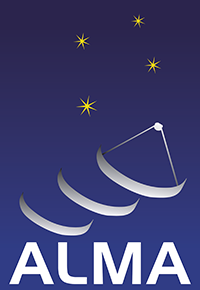
The North American ALMA Science Center (NAASC) is excited to announce the 2018 ALMA Ambassadors. The Ambassadors program is at the core of the NAASC’s efforts to reach out to potential proposal Principal Investigators, and we are grateful for their contribution to the community. We are looking forward to meeting with the Ambassadors in February at the National Radio Astronomy Observatory (NRAO) headquarters in Charlottesville, VA, and to working with them in the preparation of events at their home institutions. Training will include topics related to ALMA proposal writing, including interferometry basics, ALMA science capabilities, recent ALMA headlines, use of the Observing Tool, and guidance with speaking on these topics. The postdocs will then host a local proposal preparation workshop at their home institution – similar to an abbreviated version of Community Day and NRAO Live! events from previous observing cycles – in advance of the Cycle 6 ALMA proposal deadline in April 2018.
2018 ALMA Ambassadors
Nicholas Ballering, University of Arizona – Steward Observatory
Loreto Barcos, Joint ALMA Observatory
Statia Cook, Columbia University
Deanne Coppejans, Northwestern University
Ian Czekala, Stanford University
Steve Ertel, University of Arizona – Steward Observatory
Katie Jameson, Australian National University
Meredith MacGregor, Carnegie Institution
Kate Rowlands, Johns Hopkins University
Dary Ruiz-Rodriguez, Rochester Institute of Technology
Patrick Sheehan, The University of Oklahoma
Irene Shivaei, University of Arizona – Steward Observatory
Rui Xue, University of Iowa
SMA Call for Standard Projects Proposals – 2018A Semester

We wish to draw your attention to the currently open Call for Standard Proposals for observations with the Submillimeter Array (SMA). This call is for the 2018A semester with observing period 16 May – 15 Nov 2018. The proposal submission closes on Thursday, 08 Mar 2018.
The SMA is a reconfigurable interferometric array of eight 6-m antennas on Maunakea jointly built and operated by the Smithsonian Astrophysical Observatory and the Academia Sinica Institute of Astronomy and Astrophysics. The array operates in the 230, 345 and 400 GHz bands.
The SMA has recently completed significant upgrades in observational capability, with more under way. Currently, the SMA observes simultaneously with two orthogonally polarized receivers, one in the 230 GHz or 345 GHz band and the other in the 240 GHz or 400 GHz band, with full polarimetric observations available using the 230+240 or 345+400 band combinations. The SWARM correlator processes 8 GHz bandwidth for each receiver in each sideband, for a total of 32 GHz, at a uniform 140 kHz resolution. This 32 GHz frequency coverage can be continuous where the tuning ranges overlap for the two orthogonally polarized receivers. In short, the SMA now provides flexible, wide band frequency coverage that delivers high continuum sensitivity and excellent spectral line capabilities. A full track offers continuum sensitivity of 200 or 500 micro-Jy (1 sigma) at 230 or 345 GHz in good weather conditions (precipitable water vapor 2.5mm and 1.0mm, respectively). The corresponding line sensitivities at 1 km/s resolution are 30 and 70 mJy. The small antennas allow access to low spatial frequencies in the sub-compact configuration, and at the other extreme, the finest angular resolution with the very extended configuration at 345 GHz is ~ 0.25". The compact and extended configurations complete the range. Thus, in some ways, the characteristics and performance of the SMA are both similar and complementary to those of the stand-alone Atacama Compact Array (ACA) component of ALMA. For more information about SMA capabilities, visit the SMA Observer Center website and explore the set of SMA proposing tools. Current and archived SMA Newsletters available online provide a sampling of the wide variety of science possible with the SMA.
Please note that the Large Scale Projects program which follows a phased development, submission and review path, has now entered the full proposal development phase and PIs who submitted Notices of Intent to propose have been intimated.
For more details visit the following websites:
General | Large Scale Projects
Questions or comments regarding the Call for Standard Proposals can be addressed to sma-propose@cfa.harvard.edu and on large scale projects to sma-largescale@cfa.harvard.edu.
Grote Reber Doctoral Fellowship Program
The NRAO Grote Reber Doctoral Fellowship Program enables Ph.D. students in the final years of their thesis to conduct research at one of the NRAO sites under the supervision of an NRAO advisor. The program is jointly sponsored by NRAO and the student's home university, and supports thesis projects in radio astronomy, radio instrumentation, or computational techniques. Reber Fellowships cover student stipends for a period of up to two years, and they include an annual allocation for student travel to attend a conference.
Prospective students should identify an NRAO scientist or engineer who will serve as the advisor, and the NRAO staff member can then apply for the program on behalf of the student. Applications are accepted twice per year, with the next deadline being 6 April 2018 for positions beginning in September 2018.
Please visit our website for a complete description of the program and the application process. For more information on the Reber Fellowship or other NRAO student programs, contact Jim Braatz.
Names & Acknowledgement Policies in Publications Using NRAO Data

In initial references to the Very Large Array in any publication, please refer to this research facility as “NSF's Karl G. Jansky Very Large Array (VLA).” The acronym “VLA” may be used in subsequent references.
Publications that use VLA and/or Atacama Large Millimeter/submillimeter Array (ALMA) data should include the acknowledgement: “The National Radio Astronomy Observatory is a facility of the National Science Foundation operated under cooperative agreement by Associated Universities, Inc.”
Papers using ALMA data should also include the ALMA acknowledgement:
“This paper makes use of the following ALMA data: ADS/JAO.ALMA#YYYY.#.###.L. ALMA is a partnership of ESO (representing its member states), NSF (USA) and NINS (Japan), together with NRC (Canada), MOST and ASIAA (Taiwan), and KASI (Republic of Korea), in cooperation with the Republic of Chile. The Joint ALMA Observatory is operated by ESO, AUI/NRAO and NAOJ.”
Publication support from NRAO requires the correct naming convention of NSF's Karl G. Jansky VLA and the NRAO or ALMA acknowledgement.
More information on NRAO support for page charges, and on the facility naming convention, is online at the NRAO Library website. For questions or comments, please contact the Observatory Librarian.
Recent Media Releases
Career Opportunities
Assistant Scientist or Software Engineer: The NRAO is recruiting a Scientific staff member or Software Engineer III position (as appropriate for educational qualification) for investigation of the suitability of various imaging algorithms for ngVLA science and to derive the computing load needed to process ngVLA data through these algorithms.
SRDP Project Scientist- Associate or Scientist: The NRAO is seeking an experienced technical and scientific leader to serve as project scientist for the Science Ready Data Products (SRDP) project. The SRDP project will change radio astronomy by delivering data products that are ready to use for scientific study by a wide range of astronomers, including those not expert in interferometry, thereby making radio astronomy more accessible to the broader astronomical community. A major Observatory initiative, the multi-year SRDP project is a significant investment (100+ FTE years) to deliver “science center functionality” for NRAO’s interferometers. This project builds on the success of the pipelines already in use for the Atacama Large Millimeter/submillimeter Array, the Very Large Array (VLA), and the VLA Sky Survey, and continues NRAO’s role as a pioneer in radio astronomy.
From the Archives
Ellen Bouton

[click to enlarge]
About this month's photo: Almost from the moment NRAO took possession of the original Edgemont Road building in Charlottesville in December 1965, it was too small, and personnel numbers were expected to nearly double over 1972-1976 as planning for the Very Large Array (VLA) ramped up. In 1972, (we think) two trailers were set at the very back of the parking lot behind the building, and there they stayed for almost 30 years. At various times, they housed computer programmers, VLA project staff (before they moved to New Mexico), structural engineers, part time or visiting scientists, electronics staff, and Information Services (the early version of Education & Public Outreach), as well as being used at times for storage. As concrete plans were finally made in the early 2000s for the expansion of the building, the trailers needed to go. In this photo, taken on 31 January 2001, Sheila Marks, Billie Rodriguez, Anton Zensus, and Paul Vanden Bout are there to witness their imminent departure.
From the Archives is an ongoing series illustrating NRAO and U.S. radio astronomy history via images selected from our collections of individuals' and institutional papers. If readers have images they believe would be of interest to the Archives, please contact Ellen Bouton.


